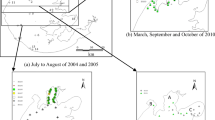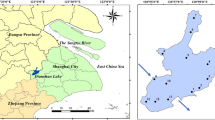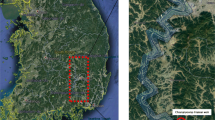Abstract
In the remote sensing of chlorophyll-a (Chla) in inland Case-II waters, the assumption that the optical parameter of Chla specific absorption coefficient \(a_{\rm ph}^{\ast}\) remains constant usually restrains application of many models. In this paper, we presented a newly developed model \(\big[ {R_{\rm rs} ^{-1}( {\lambda _1 } ) -R_{\rm rs} ^{-1}( {\lambda _2 } )} \big]\times R_{\rm rs} ( {\lambda _3 } )\times a_{\rm ph}^{\ast}{}^{-1}( {\lambda _1 } )\) which was improved on a previous three-band model to isolate interferences from \(a_{\rm ph}^{\ast}\). In terms of the importance of water optical properties in the model development, spectral and absorption characteristics were analyzed for Shitoukoumen Reservoir and Songhua Lake in Northeast China, as typical examples of inland Case-II waters. Both waters showed overwhelming absorption sum of tripton and chromophoric dissolved organic matter (CDOM) owing to their relatively low Chla contents (1.53 to 19.35 μgl − 1). According to the optical characteristics of waters studied, optimal positions for λ 1, λ 2 and λ 3 were spectrally tuned to be at 664, 684 and 705 nm, respectively. The model allowed accurate Chla estimation with a determination coefficient (R 2) close to 0.98 and a root mean square error (RMSE) of 0.87 μgl − 1. Comparison of different models further showed the stability of the improved model, implying its potential use in water color remote sensing. Although the findings underline the rationale behind the improved model, an extensive database containing data in different water conditions and water types is required to generalize its application.
Similar content being viewed by others
References
Dall’Olmo, G., & Gitelson, A. A. (2005). Effect of bio-optical parameter variability on the remote estimation of chlorophyll-a concentration in turbid productive waters: Experimental results. Applied Optics, 44, 412–422. doi:10.1364/AO.44.000412.
Dall’Olmo, G., Gitelson, A. A., & Rundquist, D. C. (2003). Towards a unified approach for estimation of chlorophyll-a in both terrestrial vegetation and turbid productive waters. Geophysical Research Letters, 30(18), 1938. doi:10.1029/2003GL018065.
Dekker, A. (1993). Detection of the optical water quality parameters for eutrophic waters by high resolution remote sensing. Ph.D. thesis, Free University, Amsterdam, The Netherlands.
Duan, H. T., Zhang, Y. Z., Zhang, B., Song, K. S., & Wang, Z. M. (2006). Assessment of chlorophyll-a concentration and trophic state for Lake Chagan using Landsat TM and field spectra data. Environmental Monitoring and Assessment, 129(1–3), 295–308. doi:10.1007/s10661-006-9362-y.
Forget, P., Ouillon, S., Lahet, F., & Broche, P. (1999). Inversion of reflectance spectra of nonchlorophyllous turbid coastal waters. Remote Sensing of Environment, 68(3), 264–272. doi:10.1016/S0034-4257(98)00117-5.
Fraser, R. N. (1998). Hyperspectral remote sensing of turbidity and chlorophyll-a among Nebraska Sand Hills lakes. International Journal of Remote Sensing, 19, 1579–1589. doi:10.1080/014311698215360.
Gitelson, A. (1992). The peak near 700 nm on radiance spectra of algae and water: Relationships of its magnitude and position with chlorophyll concentration. International Journal of Remote Sensing, 13(17), 3367–3373. doi:10.1080/01431169208904125.
Gitelson, A. A., Garbuzov, G., Szilagyi, F., Mittenzwey, K. H., Karnieli, A., & Kaiser, A. (1993a). Quantitative remote sensing methods for real-time monitoring inland water quality. International Journal of Remote Sensing, 14, 1269–1295. doi:10.1080/01431169308953956.
Gitelson, A. A., Gritz, Y., & Merzlyak, M. N. (2003). Relationship between leaf chlorophyll content and spectral reflectance and algorithms for non-destructive chlorophyll assessment in higher plant leaves. Journal of Plant Physiology, 160, 271–282. doi:10.1078/0176-1617-00887.
Gitelson, A. A., & Kondratyev, K. Y. (1991). Optical models of mesotrophic and eutrophic water bodies. International Journal of Remote Sensing, 12, 373–385. doi:10.1080/01431169108929659.
Gitelson, A. A., Schalles, J. F., & Hladik, C. M. (2007). Remote chlorophyll-a retrieval in turbid, productive estuaries: Chesapeake Bay case study. Remote Sensing of Environment, 109, 464–472. doi:10.1016/j.rse.2007.01.016.
Gitelson, A. A., Szilagyi, F., & Mittenzwey, K. (1993b). Improving quantitative remote sensing for monitoring of inland water quality. Water Research, 7, 1185–1194. doi:10.1016/0043-1354(93)90010-F.
Gonzalo, P., Claudia, Q., Esteban, B., & Beatriz, M. (2007). Phytoplankton absorption spectra along the water column in deep North Patagonian Andean lakes (Argentina). Limnologica, 37, 3–16. doi:10.1016/j.limno.2006.08.005.
Gordon, H. R., Brown, O. B., & Jacobs, M. M. (1975). Computed relationships between the inherent and apparent optical properties of a flat homogenous ocean. Applied Optics, 14(2), 417–427.
Gower, J. F. R., Doerffer, R., & Borstad, G. A. (1999). Interpretation of the 685 nm peak in water-leaving radiance spectra in terms of fluorescence, absorption and scattering, and its observation by MERIS. International Journal of Remote Sensing, 20, 1771–1786. doi:10.1080/014311699212470.
Hong, H. S., Wu, J. Y., Shang, S. L., & Hu, C. M. (2005). Absorption and fluorescence of chromophoric dissolved organic matter in the Pearl River Estuary, South China. Marine Chemistry, 97, 78–89. doi:10.1016/j.marchem.2005.01.008.
James, L. M., & Giulietta, S. F. (2002). Ocean optics protocols for satellite ocean color sensor validation, revision 3, part II. Greenbelt, MD: NASA, Goddard Space Flight Space Center.
Jerlov, N. G. (1976). Marine optics. Amsterdam: Elsevier.
Jiao, H. B., Zha, Y., Gao, J., Li, Y. M., Wei, Y. C., & Huang, J. Z. (2006b). Estimation of chlorophyll-a concentrations in Lake Tai, Chian using in situ hyperspectral data. International Journal of Remote Sensing, 27(19), 4267–4276. doi:10.1080/01431160600702434.
Jiao, H. B., Zha, Y., Li, Y. M., Huang, J. Z., & Wei, Y. C. (2006a). Trophic state level monitoring of Lake Taihu based on in situ measurements of hyperspectral reflectance. Journal of Lake Sciences, 18(4), 343–348.
Lee, Z. P., & Carder, K. L. (2004). Absorption spectrum of phytoplankton pigments derived from hyperspectral remote-sensing reflectance. Remote Sensing of Environment, 89, 361–368. doi:10.1016/j.rse.2003.10.013.
Li, Y., Huang, J., Lu, W., & Shi, J. (2006). Model-based remote sensing on the concentration of suspended sediments in Taihu Lake. Oceanologia et Limnologia Sinica, 37(2), 171–177.
Li, S., Wu, Q., Wang, X., Piao, X., & Dai, Y. (2002). Correlation between reflectance spectra and contents of chlorophyll-a in Chaohu Lake. Journal of Lake Sciences, 14, 228–234.
Lohrenz, S. E., Weidemann, A. D., & Tuel, M. (2003). Phytoplankton spectral absorption as influenced by community size structure and pigment composition. Journal of Plankton Research, 25(1), 35–61. doi:10.1093/plankt/25.1.35.
Ma, R., Tang, J., & Dai, J. (2006a). Bio-optical model with optimal parameter suitable for Taihu Lake in water color remote sensing. International Journal of Remote Sensing, 27(19), 4305–4328. doi:10.1080/01431160600857428.
Ma, R., Tang, J., Dai, J., Zhang, Y., & Song, Q. (2006b). Absorption and scattering properties of water body in Taihu Lake, China: Absorption. International Journal of Remote Sensing, 27(19), 4277–4304. doi:10.1080/01431160600851835.
Mobley, C. D. (1994). Light and water: Radiative transfer in natural waters. California: Academic.
Mobley, C. D. (1999). Estimation of the remote-sensing reflectance from above-surface measurements. Applied Optics, 38, 7442–7455. doi:10.1364/AO.38.007442.
Neville, R. A., & Gower, J. F. R. (1977). Passive remote sensing of phytoplankton via chlorophyll a fluorescence. Journal of Geophysical Research, 82, 3487–3493. doi:10.1029/JC082i024p03487.
Prieur, L., & Sathyendranath, S. (1981). An optical classification of coastal and oceanic waters based on the specific spectral absorption curves of phytoplankton pigments, dissolved organic matter, and other particulate materials. Limnology and Oceanography, 26, 671–689.
Sakshaug, E., Bricaud, A., Dandonneau, Y., Falkowski, P. G., Kiefer, D. A., Legendre, L., et al. (1997). Parameters of photosynthesis: Definitions, theory and interpretation of results. Journal of Plankton Research, 19, 1637–1670. doi:10.1093/plankt/19.11.1637.
Sathyendranath, S. (2000). Remote sensing of ocean color in coastal, and other optically-complex, waters. IOCCG Report, 3. Dartmouth, Nova Scotia: IOCCG Project Office, 140.
Sathyendranath, S., Lazzara, L., & Prieur, L. (1987). Variations in the spectral values of specific absorption of phytoplankton. Limnology and Oceanography, 32, 403–415.
Tang, J. W., Wang, X. M., Song, Q. J., Li, T. J., Cheng, J. Z., Huang, H. J., et al. (2004). The statistic inversion algorithms of water constituents for the Huanghai Sea and the East China Sea. Acta Oceanologica Sinica, 23(4), 617–626.
Wang, Y. P., Xia, H., Fu, J. M., & Sheng, G. Y. (2004). Water quality change in reservoirs of Shenzhen, China: Detection using Landsat/TM data. The Science of the Total Environment, 328, 195–206. doi:10.1016/j.scitotenv.2004.02.020.
Yue, J., Wang, Y. L., Li, Z. G., Zhang, Y., & Bu, X. G. (2006). Spatial–temporal trends of water quality and its influence by land use: A case study of the main rivers in Shenzhen. Advance in Water Science, 17(3), 359–364.
Zhao, D. Z., Zhang, F. S., Du, F., Zhao, L., & Guo, H. (2005). Interpretation of sun-induced fluorescence peak of chlorophyll-a on reflectance spectrum of algal waters. Journal of Remote Sensing, 9(3), 265–270.
Zhou, G. H., Liu, Q. H., Ma, R. H., & Tian, G. L. (2008). Inversion of chlorophyll-a concentration in turbid water of Lake Taihu based on optimized multi-spectral combination. Journal of Lake Sciences, 20(2), 153–159.
Zimba, P. V., & Gitelson, A. (2006). Remote estimation of chlorophyll concentration in hyper-eutrophic aquatic systems: Model tuning and accuracy optimization. Aquaculture (Amsterdam, Netherlands), 256, 272–286. doi:10.1016/j.aquaculture.2006.02.038.
Author information
Authors and Affiliations
Corresponding author
Rights and permissions
About this article
Cite this article
Xu, J., Li, F., Zhang, B. et al. Estimation of chlorophyll-a concentration using field spectral data: a case study in inland Case-II waters, North China. Environ Monit Assess 158, 105–116 (2009). https://doi.org/10.1007/s10661-008-0568-z
Received:
Accepted:
Published:
Issue Date:
DOI: https://doi.org/10.1007/s10661-008-0568-z




